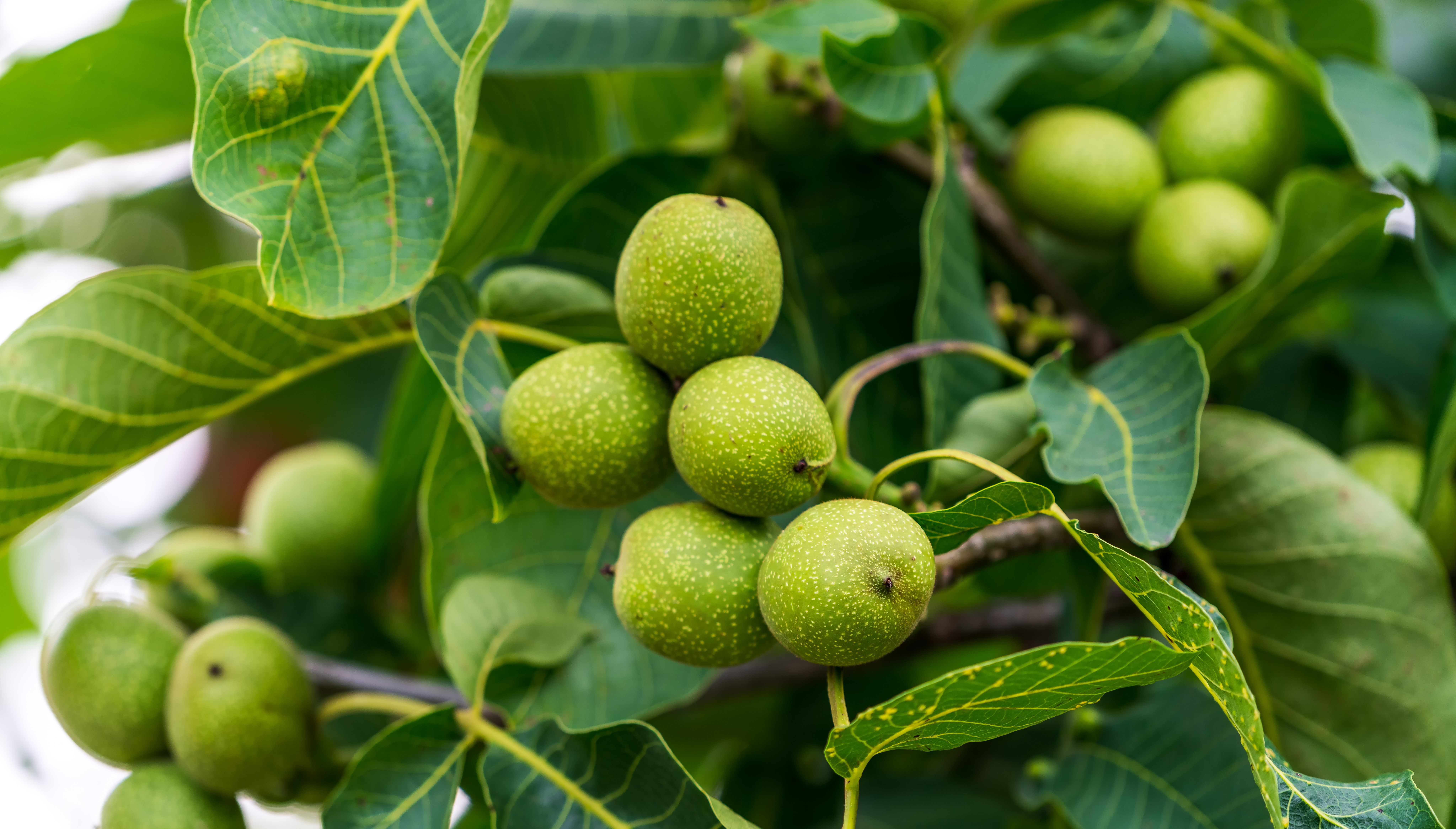A Rapid Approach to Extract and Separate Compounds from Juglands mandshurica Maxim. Exocarp
This study employed an integrated method of homogenization-ultrasound-assisted extraction followed by high-speed countercurrent chromatography for efficient separation of naphthoquinones and diarylheptanes from green walnut husks.
In a collaborative effort between Northeast Forestry University and Beijing Forestry University, a team of researchers has explored an innovative integrated method for the extraction and separation of specific compounds, such as naphthoquinones and diarylheptanes, from Juglands mandshurica Maxim. exocarp, commonly known as green walnut husks (1). Published in the Journal of Separation Science, the study focuses on enhancing efficiency and speed in obtaining high-purity compounds.
Summer tree garden of nut. Branch of green walnuts. | Image Credit: © Vadim - stock.adobe.com

The combination of naphthoquinones and diarylheptanes in green walnut husks are useful examples of the variety of medicinal compounds found within the natural green walnut matrix. Researchers are exploring these compounds not only for their individual therapeutic attributes but also for potential synergistic effects when they are present together.
The research introduces a unique approach that combines ultra-turrax homogenization (UTH) with ultrasound-assisted extraction (UAE) technology, followed by high-speed countercurrent chromatography (HSCCC). This integrated strategy aims to streamline the extraction and separation processes, providing a rapid and resource-efficient method for obtaining target compounds.
According to the results of the study, the hybrid UTH-UAE extraction method demonstrated superior efficiency that surpassed conventional UAE and UTH methods by themselves. The team reported a 2.49- and 2.36-fold increase in efficiency compared to UAE, and a 1.39- and 1.34-fold increase compared to UTH, all achieved in a significantly shorter timeframe. This outcome, the authors said, highlights the effectiveness of the integrated approach in accelerating the extraction process without compromising the quality of the obtained compounds.
Following the extraction phase, the researchers employed HSCCC for further separation and purification. Six target compounds—regiolone (RE), juglone (JU), myricatomento-genin (MG), galleon (GA), 2-oxatrycyclo[13.2.2.13,7]eicosa-3,5,7(20),15,17,18-hexaen-10-16-diol (OE), and juglanin A (JA)—were successfully separated with purities exceeding 95.37% and final recovery rates surpassing 84.71%. This achievement underlines the efficacy of HSCCC in obtaining high-purity compounds from complex mixtures.
The integrated strategy presented in this study not only ensures the rapid extraction of target compounds, but also contributes to significant time and solvent savings. By combining UTH and UAE for extraction, researchers can achieve enhanced efficiency, and the subsequent HSCCC process ensures the isolation of compounds with high purity and recovery rates. This methodology holds promise for future applications in the natural products separation field, offering a more streamlined and resource-conscious approach.
In conclusion, this collaborative research effort has resulted in an integrated method that marks an advancement in the extraction and separation of compounds from Juglands mandshurica Maxim. exocarp. Furthermore, it may set the stage for more efficient and sustainable future practices in the isolation of valuable compounds from natural sources.
This article was written with the help of artificial intelligence and has been edited to ensure accuracy and clarity. You can read more about our policy for using AI here.
Reference
(1) Chang, Y.- H.; Yu, L.; Yang, H.; Xu, J.; Fu, Y.- J. An Integrated Approach of Homogenization-Ultrasound-Assisted Extraction Followed by High-Speed Countercurrent Chromatography for Rapidly Preparative Separation Naphthoquinones and Diarylheptanes from Juglands mandshurica Maxim. Exocarp. J. Sep. Sci. 2023, e2300370. DOI: 10.1002/jssc.202300370
Study Explores Thin-Film Extraction of Biogenic Amines via HPLC-MS/MS
March 27th 2025Scientists from Tabriz University and the University of Tabriz explored cellulose acetate-UiO-66-COOH as an affordable coating sorbent for thin film extraction of biogenic amines from cheese and alcohol-free beverages using HPLC-MS/MS.
Multi-Step Preparative LC–MS Workflow for Peptide Purification
March 21st 2025This article introduces a multi-step preparative purification workflow for synthetic peptides using liquid chromatography–mass spectrometry (LC–MS). The process involves optimizing separation conditions, scaling-up, fractionating, and confirming purity and recovery, using a single LC–MS system. High purity and recovery rates for synthetic peptides such as parathormone (PTH) are achieved. The method allows efficient purification and accurate confirmation of peptide synthesis and is suitable for handling complex preparative purification tasks.







